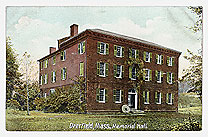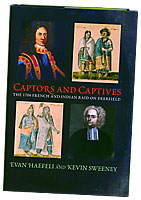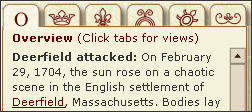![]()
|
About This Site : Getting Started | Contact | About This Project | How To | Honors | Credits | Tech Info Page Contents: Project History
This website exhibit grows directly out of the original mission of the Museum when it was founded in 1870. At that time, a group of residents, concerned that the younger generation knew little of the region's history—particularly the 1704 raid on Deerfield—formed the Pocumtuck Valley Memorial Association (PVMA), with the goal of creating a museum that would "memorialize" the past and the Native peoples of the region. The website builds on the scholarship, relationships with Native groups, and expertise that have developed over time concerning the attack, and that have been finely honed in preceding PVMA/Memorial Hall Museum projects. Those projects include:
Why an Online Museum Exhibit?
Even in the best museum exhibits that do an excellent job of educating audiences about different cultural views, the medium of a physical museum exhibit limits the degree to which diverse perspectives can be presented and easily compared by the viewer. Comparisons among perspectives are best understood when a viewer can rapidly and effortlessly move from one to the other, appreciating the points of similarity and difference, without being required to remember one before learning the next. PVMA/Memorial Hall Museum's online website exhibit allows us to use programming innovation to achieve this goal. In addition, this web-based exhibit provides an opportunity to overcome the limitations (transportation, weather, geography) of our rural location so that we may engage many new audiences, as well as re-engage existing audiences. Finally, it is far easier to acquire images of artifacts from other institutions, than the actual artifacts themselves. For all of these reasons, we are pleased to offer a "virtual museum exhibit" to the general public.
Historical Accuracy
Drawing upon the recent scholarship of noted scholars in the field, the advice and wisdom of collaborating cultural organizations, as well as our own research into artifacts, maps, and oral histories, we have endeavored to tell the story of the Raid on Deerfield from the perspectives of the five groups who were actually present at the event: Wendat (Huron), Kanienkehaka (Mohawk), Wobanakiak (Abenaki), French, English. And so, the story of the Deerfield Raid is really not one story; nor is it even five stories. Rather, it is many stories—stories that can be read and experienced in the character narratives that form the heart of this website, and which are reflected in the historic scenes, artifacts, documents, maps and timeline which give both depth and substance to the website. Along with these many stories, come different presentations and interpretations of the facts, different meanings that have been made out of the experience, and different stories that continue to be told. There is no "one truth" on this website; rather, we ask you to consider all the truths, meanings and stories about this event, the crosscurrents and forces that led up to it, and its powerful legacy.
Goals and Design
The goals of this website are threefold: 1) Engage the audience in plausible and compelling stories; 2) Accurately and fairly represent competing perspectives surrounding a controversial event; and 3) Insure an equitable and sophisticated interpretation of the material. To achieve these goals, we have stressed the following program elements:
Ongoing Evolution of This Site
As February 29, 2004 marks the 300th anniversary of the Deerfield Raid, it provided an ideal launch date for a website that would both commemorate the event, and re-interpret it by telling its many stories from the perspectives of the five groups who were present. However, the website is not complete! It will continue to grow and evolve through October of 2005. We hope you will come back and visit us often. Key dates for updating the site include May 2004 and October 2004.
|
![]()
About This Site
Resources
Glossary
Teachers' Guide
Site Map
How To
© 2020 PVMA / Memorial Hall Museum




